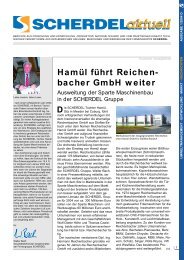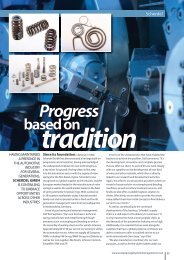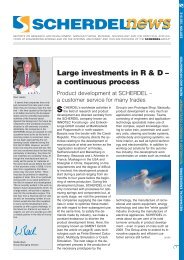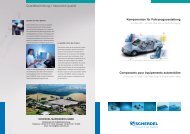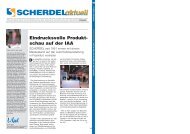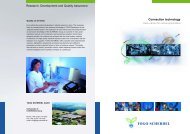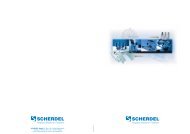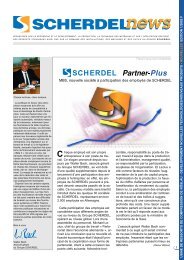Valve springs success- ful in AUDI diesel engine - Scherdel GmbH
Valve springs success- ful in AUDI diesel engine - Scherdel GmbH
Valve springs success- ful in AUDI diesel engine - Scherdel GmbH
You also want an ePaper? Increase the reach of your titles
YUMPU automatically turns print PDFs into web optimized ePapers that Google loves.
RESEARCH<br />
Potential of modern spr<strong>in</strong>g materials for spr<strong>in</strong>g components<br />
subjected to dyna mic stress <strong>in</strong> the valve tra<strong>in</strong><br />
New eng<strong>in</strong>e designs require <strong>spr<strong>in</strong>gs</strong> with improved characteristics and enhanced load-bear<strong>in</strong>g capacity<br />
- Choice of material is crucial - paper presented at the conference of the Association of German Eng<strong>in</strong>eers (part 1)<br />
TECHNOLOGY & PRODUCT DEVELOPMENT - PROCESS OPTIMIZATION - NEWS AND INFORMATION<br />
Authors:<br />
Dr.-Ing. Hilmar Brödler,<br />
Dipl.-Ing. Wolfgang Stark,<br />
Jürgen Hartmann<br />
SCHERDEL <strong>GmbH</strong>,<br />
Marktredwitz<br />
Paper presented by Dr.<br />
Hilmar Brödler at the 2nd<br />
conference of the Association<br />
of German Eng<strong>in</strong>eers,<br />
"<strong>Valve</strong> tra<strong>in</strong> and cyl<strong>in</strong>der<br />
head", on 25./26.10.2006<br />
<strong>in</strong> Leonberg<br />
Diagram 1: Summary of valvespr<strong>in</strong>g<br />
materials.<br />
M<br />
odern valve-tra<strong>in</strong> designs and<br />
<strong>in</strong>creas<strong>in</strong>gly variable factors <strong>in</strong><br />
the cyl<strong>in</strong>der head <strong>in</strong>crease the work<strong>in</strong>g<br />
load on the various spr<strong>in</strong>g elements,<br />
which have to be adapted to meet future<br />
requirements – among other th<strong>in</strong>gs<br />
and <strong>in</strong> particular by the use of higherstrength<br />
materials. New materials,<br />
processes and designs are available<br />
and are be<strong>in</strong>g used to an <strong>in</strong>creas<strong>in</strong>g extent.<br />
Introduction<br />
The <strong>in</strong>creas<strong>in</strong>gly str<strong>in</strong>gent requirements<br />
relat<strong>in</strong>g to the emission and fuel<br />
consumption values of <strong>in</strong>ternal combustion<br />
eng<strong>in</strong>es, which are associated with<br />
a large number of <strong>in</strong>dividual measures,<br />
<strong>in</strong> particular m<strong>in</strong>imization of mass and<br />
the reduction of power loss due to friction,<br />
as well as the greater demands<br />
made on the dynamics of vehicle movement,<br />
mean an <strong>in</strong>crease <strong>in</strong> the requirements<br />
relat<strong>in</strong>g to the different spr<strong>in</strong>g elements<br />
<strong>in</strong> the valve tra<strong>in</strong>. The new<br />
down-siz<strong>in</strong>g concepts – often with supercharged<br />
eng<strong>in</strong>es and, <strong>in</strong> some cases,<br />
comb<strong>in</strong>ed with high-speed concepts<br />
– call for a valve spr<strong>in</strong>g with good dynamic<br />
characteristics and, as a rule, of<br />
the same dimensions or, as the case<br />
may be, even smaller. Ris<strong>in</strong>g eng<strong>in</strong>e<br />
temperatures due to direct <strong>in</strong>jection<br />
systems, <strong>in</strong>creased metal-cladd<strong>in</strong>g of<br />
the eng<strong>in</strong>e and various other <strong>in</strong>fluential<br />
factors additionally <strong>in</strong>crease the temperatures<br />
which the components have<br />
to withstand. Exhaust-gas soot filters <strong>in</strong><br />
<strong>diesel</strong> eng<strong>in</strong>es or additional filters <strong>in</strong> the<br />
exhaust tract of petrol eng<strong>in</strong>es raise the<br />
exhaust counterpressure at the exhaust<br />
valve and necessitate a greater clos<strong>in</strong>g<br />
pressure while the dimensions rema<strong>in</strong><br />
unchanged.<br />
These examples demonstrate how the<br />
various types of spr<strong>in</strong>g <strong>in</strong> the valve tra<strong>in</strong><br />
– <strong>in</strong> particular the valve <strong>spr<strong>in</strong>gs</strong>, <strong>spr<strong>in</strong>gs</strong><br />
for switchable bucket tappets, compression<br />
<strong>spr<strong>in</strong>gs</strong> for hydraulic valve-play<br />
compensation, torsion <strong>spr<strong>in</strong>gs</strong> and spiral<br />
<strong>spr<strong>in</strong>gs</strong> for variable valve-tra<strong>in</strong> elements,<br />
as well as <strong>spr<strong>in</strong>gs</strong> for camshaft<br />
adjusters and others – are subjected to<br />
ever-<strong>in</strong>creas<strong>in</strong>g stress, while the performance<br />
of the components must be cont<strong>in</strong>uously<br />
improved and, <strong>in</strong> particular,<br />
their weight and dimensions steadily reduced.<br />
In addition to achiev<strong>in</strong>g an optimum<br />
component design us<strong>in</strong>g modern design<br />
tools, for years now particular attention<br />
has been paid to the materials<br />
used and the ways <strong>in</strong> which they are<br />
processed, <strong>in</strong> order to meet the demands<br />
made on the spr<strong>in</strong>g elements.<br />
The follow<strong>in</strong>g is <strong>in</strong>tended to provide a<br />
general idea of the materials currently<br />
<strong>in</strong> use or <strong>in</strong> the process of development,<br />
as well as their manufacturers<br />
and manufactur<strong>in</strong>g processes. Reference<br />
is also made to the design requirements<br />
and to the handl<strong>in</strong>g of these<br />
materials, as well as to the techniques<br />
and processes used.<br />
Diagram 2a: Relative <strong>in</strong>creases <strong>in</strong> the price of<br />
valve-spr<strong>in</strong>g wire.<br />
Materials<br />
rod-wire manufacturers<br />
Tak<strong>in</strong>g the valve-spr<strong>in</strong>g as an example,<br />
the follow<strong>in</strong>g describes the most<br />
commonly used materials. Diagram 1<br />
provides some reference values for<br />
the three material qualities VD SiCr,<br />
VD SiCrV and VD SiCrNiV, given that<br />
the mechanical-technological parameters<br />
refer to wire with a diameter of<br />
3.0 mm.<br />
The three materials SiCr, SiCrV and<br />
SiCrNiV are the valve-spr<strong>in</strong>g materials<br />
most frequently used today. These materials,<br />
which are readily available from<br />
various manufacturers, are characterized<br />
by the fact that they are produced<br />
us<strong>in</strong>g the Superclean process, i.e. deoxidiz<strong>in</strong>g<br />
with silicon, and subjected to<br />
elaborate test<strong>in</strong>g procedures dur<strong>in</strong>g billet<br />
treatment, roll<strong>in</strong>g and the various<br />
wire-draw<strong>in</strong>g stages. Particularly for<br />
spr<strong>in</strong>g elements subjected to a high level<br />
of dynamic stress, these three materials<br />
provide an excellent surface quality<br />
and a very low <strong>in</strong>clusion rate. The<br />
Superclean process ensures that the<br />
composition of <strong>in</strong>clusions <strong>in</strong> the threematerial<br />
system SiO2-CaO-Al2O3 is<br />
regulated <strong>in</strong> such a way that they are<br />
ductile and therefore produce only a<br />
very slight notch effect <strong>in</strong> the metal<br />
lattice. In addition, there are specifications<br />
relat<strong>in</strong>g to surface-crack detection<br />
to a permissible depth of 40 µm and<br />
relat<strong>in</strong>g to the def<strong>in</strong>ed depth of partial<br />
decarburization.<br />
The three materials mentioned have<br />
the follow<strong>in</strong>g characteristics:<br />
SiCr - High-strength standard material<br />
with good ductility and very good crackarrest<strong>in</strong>g<br />
ability<br />
SiCrV - Higher-strength material with a<br />
f<strong>in</strong>er structure<br />
SiCrNiV - Super high-strength material<br />
with very good temperature resistance,<br />
particularly suitable for nitration.<br />
In addition to the technical characteristics<br />
of these materials, an important<br />
factor is their cost. The follow<strong>in</strong>g summary<br />
provides a comparison of the cost<br />
of the <strong>in</strong>dividual qualities of material.<br />
The estimated proportion of the use of<br />
these materials is also <strong>in</strong>dicated.<br />
(To be cont<strong>in</strong>ued) (Dr. Hilmar Brödler)<br />
wire-drawers<br />
Diagram 2b: Estimate of the proportion<br />
of the use of the different<br />
valve-spr<strong>in</strong>g qualities <strong>in</strong> relation to<br />
the total.<br />
Supplier market<br />
Today there is only a limited number<br />
of suppliers who manufacture<br />
these sophisticated materials. Here<br />
we must dist<strong>in</strong>guish between the<br />
rod-wire manufacturers and those<br />
<strong>in</strong>volved <strong>in</strong> the next stage, the<br />
wire-drawers. Diagram 3 illustrates<br />
the current global situation <strong>in</strong> relation<br />
to the supply cha<strong>in</strong>s – rod-wire<br />
manufacturers / wire-drawers – for<br />
valve-spr<strong>in</strong>g wires.<br />
(as of: 10/2006)<br />
TECHNOLOGY & PRODUCT DEVELOPMENT - PROCESS OPTIMIZATION - NEWS AND INFORMATION<br />
6<br />
1)<br />
<strong>in</strong> the case of nitrated <strong>spr<strong>in</strong>gs</strong> a<br />
reduction <strong>in</strong> sett<strong>in</strong>g loss is possible.<br />
7



